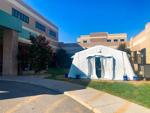Over the last few weeks, hospital systems across Virginia have been sounding alarms over the latest coronavirus surge, largely driven by the highly infectious delta variant.
In Southwest Virginia, Ballad Health is facing its “worst-case scenario” with more than 700 COVID-19 patients. In Northern Virginia, hospitals already nearing capacity with COVID-19 cases have been overwhelmed by recently arrived Afghan refugees. And on Thursday, the Virginia Hospital and Healthcare Association issued a statement on behalf of more than three dozen medical groups, pleading for unvaccinated Virginians to get their shots.
“In just two months, hospitalizations have increased by 1,008% and new cases have jumped by 1,217%,” it read. “With hospital inpatient and ICU beds already filling ahead of a looming fall surge, it is imperative for unvaccinated Virginians to do their part to help save lives and slow the spread of this deadly virus by getting vaccinated.”
Nowhere has the latest spike in cases been more obvious than in Virginia’s beleaguered emergency rooms, where unvaccinated and often seriously ill COVID-19 patients are adding stress to an already maxed-out system. Dr. Todd Parker, president-elect of the Virginia College of Emergency Physicians, said almost every hospital across the state is struggling with overcrowding, widespread staffing shortages and difficulty transferring patients — who frequently require higher levels of care — to facilities experiencing the exact same challenges.
The ongoing surge is sending ripple effects across Virginia’s medical system. On Sunday, Carilion said it set up a tent outside the emergency department at the New River Valley Medical Center in Christiansburg, expanding its waiting area as visits continue to swell. And the crush of patients isn’t unique to Southwest Virginia. Across the state, emergency medicine physicians are reporting an ER “safety net” on the brink of crisis.

Carilion, a hospital system in Southwest Virginia, erected a tent outside one of its emergency rooms in preparation for a growing spike in visits.
When the Mercury reached out with questions about the state of emergency rooms, the emergency physicians group polled its Board of Directors, a group of doctors representing multiple geographic regions. The association didn’t disclose the names of individual health systems or physicians, who weren’t authorized to speak on their hospital’s behalf, said spokesman Jeff Kelley.
But many of the responses painted a grim picture of how the ongoing pandemic continues to affect providers. One physician from a hospital in Eastern Virginia described the emergency department as a “second ICU at this point.”
“We had to bring in more ventilators because we are running out,” the physician said. Another doctor from a hospital in Southwest Virginia said the facility has experienced several deaths in the waiting area of its Level 1 trauma center among patients “we wanted to room immediately but we just do not have the space nor the staff for it.”
“In our little community EDs, we are seeing people languish waiting for a bed to become available at a tertiary care center” — larger hospitals that can provide specialty services or higher levels of treatment — the physician said. In some of those cases, patients are admitted on a progressive care level, which requires regular monitoring but isn’t considered critical. By the time a space becomes available, though, the physician said many patients have been upgraded to ICU-level care.
“I have also had to palliate patients rather than admit them because the only available inpatient bed is states away and family would rather be with them than send them away,” the doctor said. “So I just send them home on hospice.”
There are multiple reasons why the current surge is disrupting emergency department operations at a far greater level than earlier in the pandemic. For one thing, there’s more demand. Julian Walker, vice president of communications for VHHA, said early stay-at-home orders — coupled with widespread fear of contracting the virus at the hospital — led many non-COVID-19 patients to avoid the emergency room, even during genuine crises. In 2020, Virginia hospitals saw a 30% decline in ED visits, even after the state began to reopen.
For most hospitals, that period is over. Parker said many emergency departments are fielding larger numbers of patients than they did before the start of the pandemic. Doctors from the northern, central, eastern, southwestern and Shenandoah regions of the states all reported slightly to “significantly” higher patient volumes in recent weeks.
Not every case is an emergency, including one patient in Northern Virginia who came to the hospital with a stomach ache after drinking too much soda (“this really happened,” the attending physician said.) But overall, patients — and not just COVID-19 patients — are presenting with more complex medical problems.
“To use the medical term, we’re seeing sicker people,” Parker said. Many adults delayed medical care during the pandemic, and Walker said hospitals are now experiencing what he described as “pent-up demand.” Major shifts in medical care have also contributed to the complications.
In the first month of the pandemic, Gov. Ralph Northam ordered a temporary halt to elective procedures to preserve hospital capacity. Telehealth visits have also become commonplace, but one doctor from Northern Virginia said they haven’t reduced emergency room use. In some instances, primary care doctors direct patients to the hospital if they can’t perform a physical exam or can’t get a clear read on the severity of a patient’s symptoms.
“We’ve also been seeing more complications from the over-prescription of medications such as antibiotics,” the physician said. According to Parker, that also occurs when patients aren’t being examined in-person.
“When people can’t provide the nuanced level of care they usually do, they tend to overprescribe,” he said. “Not everyone does this. But say someone has an earache. If I’m doing telemedicine, I can’t look in their ears, so a lot of urgent cares are just prescribing them antibiotics.”
More than anything, though, it’s the massive spike in COVID-19 cases that’s driving the disruption. Not every hospital is experiencing the same spike — another physician from Northern Virginia reported admitting just one coronavirus patient over the last three months. But Parker said the situation is especially critical in regions with low vaccination rates.

A nurse volunteering with the Virginia Medical Reserve Corps waits for patients at a free testing site in Richmond last year. She identified herself as Melissa, but her last name was inaudible at a distance through the protective masks she was wearing.
Ballad, for instance, is treating more COVID-19 patients than it did during the system’s previous peak in early January. Some are being monitored at home through telehealth visits, but more than half are hospitalized. Of those hospitalized patients, more than one quarter are in the ICU and nearly 20% are on a ventilator. Only 40.2% of people in the system’s service area are fully vaccinated.
“It’s the highest census I can remember us having in the three and a half years I’ve been working for Ballad Health,” chief operating officer Eric Deaton said in a Thursday news briefing. Other hospitals in the “near Southwest,” an area that extends roughly from Blacksburg to Roanoke, have also experienced a rising number of hospitalizations.
Carilion, Centra, LewisGale, Sovah Health and the Salem VA Medical Center reported a total of 326 COVID-19 patients this week, 98 of whom were admitted into the ICU. In early June, all five systems had a total of 61 coronavirus patients, with 16 ICU admissions.
Across the state, though, physicians say virtually all COVID-19 hospitalizations have been among unvaccinated patients — particularly cases requiring ICU or ventilator care. The surge has created a perfect storm for ERs, Parker said.
Doctors are now treating severe infections in addition to high-need and medically complex patients without coronavirus. As a result, more patients in general are being admitted from the emergency room, driving congestion throughout the hospital.
“It’s not the volume that’s killing us,” one emergency medicine doctor from Southwest Virginia said. Instead, it’s a growing influx of patients from the ICU and other hospital departments “boarding” in the emergency room. Another doctor from the same region said 61 of the 68 beds in a local emergency room were recently taken up by other inpatients.
Overcrowding, now endemic in Virginia emergency rooms and in hospitals across state lines, is creating delays across the system. LewisGale, Sovah and Carilion have all had to divert patients or decline transfers over the past two weeks.
“When we issue this ‘diversion’ status, we will not refuse care for any patient presented at our hospital, especially those in critical condition,” LewisGale spokesperson Chris Finley wrote in an email last week. But it is a sign that emergency rooms are overwhelmed. At this point, though, it’s also increasingly difficult to find alternative sites for patients. One doctor in Central Virginia said there are currently 10 emergency departments in the area on ambulance diversion.
“There have been times this past week at the start of the day shift that every monitored bed had an admitted patient,” the doctor continued. In most cases, though, the issue isn’t available bed space, but understaffing. Another emergency room physician in the Shenandoah region said there’s currently a severe shortage of clinical nurses, with “all available staff redeployed to assist in response to the COVID crisis.”
“This problem started months and months and months ago,” Parker added. “The problem is that nurses are leaving and going elsewhere. I think there is a huge burnout factor from doing this for so long.”

Physicians with the Carilion Clinic in Roanoke wear enhanced personal protective equipment inside the health system’s facilities.
It’s not just nurses who are feeling the strain. Burnout among medical providers has been a serious concern for months, but many doctors said the downstream effects from the ongoing surge are only making things worse. Long emergency room delays are becoming more common, with waits between six to eight hours on some days, one physician from Central Virginia said. Pediatric COVID-19 patients are becoming more common in some areas. And transferring patients to get the care they need is a frequent challenge.
“One hospital transferred a patient to us after calling more than 20 hospitals in four different states,” the same physician said. And similar delays have spread across the continuum of care, from processing orders for medication to imaging and lab work. Another doctor from Northern Virginia said overcrowding in other hospital departments has led to pushback admitting patients from the ED. The stress of caring for those patients and the “fight for appropriate care” just adds to the strain.
“Everyone has been pushing hard for so many months and this latest surge is grinding everyone down,” added a physician from Eastern Virginia. “We aren’t health care heroes. No one is sending food or thanks. We are just drowning with no one even noticing.”
"emergency" - Google News
September 13, 2021 at 08:10PM
https://ift.tt/3C4oHSk
The COVID-19 surge is overwhelming emergency rooms across Virginia - Fauquier Times
"emergency" - Google News
https://ift.tt/2VVGGYQ
https://ift.tt/3d7MC6X
emergency
Bagikan Berita Ini














0 Response to "The COVID-19 surge is overwhelming emergency rooms across Virginia - Fauquier Times"
Post a Comment